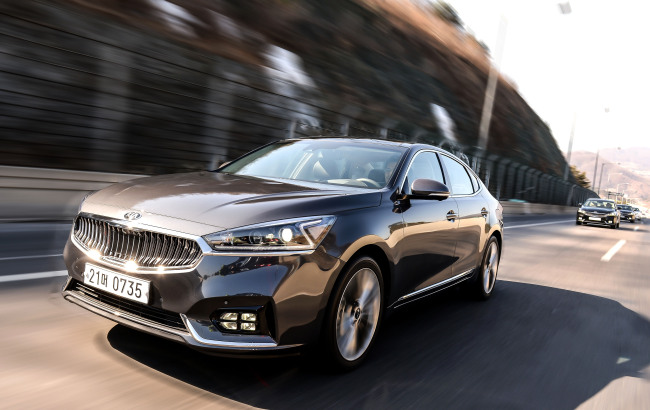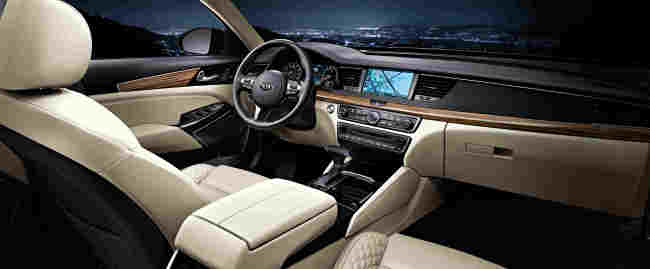[Behind the Wheel] All-new K7: Masculine but soft
Kia’s new luxury sedan highlights contrasting features of power, comfort
By 조정은Published : Feb. 4, 2016 - 20:12
Driving Kia’s all-new K7 for the 162-kilometer round-trip between Seoul and Chuncheon was like taking a bath in hot and cold tubs in rotation.
The new generation of the 3.3-liter gasoline K7 excelled in power along with its adrenaline-pumping front-exterior, but also offered a sense of comfort and elegance at the same time while speeding up and down the highway.
Engine vibration and wind noises were hardly felt between the speed range of 150-170 kilometers per hour, with the pleasure of driving magnified from the high-end audio system featuring Krell’s dynamic sound.

At first, the K7 gave the impression of a young sports sedan, with an eye-catching negative-type vertical grille as well as the futuristic Z-shaped line linking the light-emitting diode headlamps.
But taking the front driver seat quickly shifted this idea. The interior furbished with quilted leather and the center fascia dominated by state-of-the-art technology accentuated the all-new K7’s attempt to take its name to the league of global luxury sedan.
The fully changed second generation of K7 was launched on Jan. 25 in South Korea, targeting 40-something passionate motorists who think highly of stability control as well as speed and power.
The new K7 is the first mass-produced car with an eight-speed automatic transmission for its 3.3-liter gasoline direct-injection models. This proud development of Kia is the main component that enhances fuel efficiency and guarantees better driver ability. The new transmission replacing the six-speed gearbox from its previous model boosts fuel efficiency about 7 percent for the gasoline-powered K7 and 6 percent for the diesel model, the carmaker said.
During the test-drive Tuesday, the new K7 got 9.6 kilometers per liter on an 81-kilometer one-way trip from Seoul to Chuncheon, slightly lower than its official fuel efficiency of 10 kilometers per liter.
It offered four different driving modes -- eco, smart, comfort and sport -- to suit different tastes of drivers in and out of the country. Except for sport mode, the three others felt nearly the same, offering a smooth but not-so-fun driving experience on the highway. Braking was not satisfactory, as it seemed less responsive than other European cars.

The classy and refined space was enough to make up the driving experience, drawing a dramatic contrast to the image of a masculine sedan outside.
Kia, South Korea’s second-largest carmaker, believes that these contrasting features of the all-new K7 will help it dominate the nation’s mid- and large-sized sedan market.
“The all-new K7 will not only play a central role in achieving Kia Motor’s sales goal this year, but also play a pivotal role in strengthening Kia’s brand competitiveness in the future,” said Kim Chang-shik, vice president of the carmaker’s domestic sales office.
“As a dominant player in the mid- and large-sized sedan market, we will show off (the All-new K7’s) differentiated and luxurious design, options and materials that go beyond one’s expectation as well as competitive prices and quality.”
Since its debut on Jan. 25, Kia has sold more about 10,000 units including preordered vehicles.
Between Dec. 12 and Jan. 25, the carmaker got 7,500 preorder contracts, reflecting the huge expectations for the new vehicle. An average of 660 cars are being sold daily, a 35 percent increase from the first generation of K7 vehicles released in 2009, the carmaker said.
The all-new K7, called the Cadenza in the U.S. is expected to begin global sales in the second half of the year, starting from the Middle East market and then to North America.
The price of the model sold in South Korea ranges from 30.8 million won ($25,660) to 39.4 million won. The price varies on the power train and other options.
By Cho Chung-un (christory@heraldcorp.com)








![[Graphic News] More Koreans say they plan long-distance trips this year](http://res.heraldm.com/phpwas/restmb_idxmake.php?idx=644&simg=/content/image/2024/04/17/20240417050828_0.gif&u=)
![[KH Explains] Hyundai's full hybrid edge to pay off amid slow transition to pure EVs](http://res.heraldm.com/phpwas/restmb_idxmake.php?idx=644&simg=/content/image/2024/04/18/20240418050645_0.jpg&u=20240419100350)





![[From the Scene] Monks, Buddhists hail return of remains of Buddhas](http://res.heraldm.com/phpwas/restmb_idxmake.php?idx=652&simg=/content/image/2024/04/19/20240419050617_0.jpg&u=20240419175937)

![[KH Explains] Hyundai's full hybrid edge to pay off amid slow transition to pure EVs](http://res.heraldm.com/phpwas/restmb_idxmake.php?idx=652&simg=/content/image/2024/04/18/20240418050645_0.jpg&u=20240419100350)

![[Today’s K-pop] Illit drops debut single remix](http://res.heraldm.com/phpwas/restmb_idxmake.php?idx=642&simg=/content/image/2024/04/19/20240419050612_0.jpg&u=)